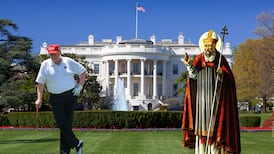When asked what he had missed most during four years' imprisonment, Charles Kickham replied: "Children and women and fires." This gentle Fenian was released from Woking jail in March 1869, broken in health.
On returning to Mullinahone, Co Tipperary, his hearing and eyesight - damaged since youth - continued to deteriorate. None the less, he completed his blockbuster, Knocknagow, which he dedicated to his nieces, Annie and Josie Cleary. According to Kickham's biographer, Prof Vincent Comerford, the two girls entered "intimately into the making of Knocknagow". But they were soon condemned to the emigrant ship. "Good Lord," Kickham wrote to Jeremiah O'Donovan Rossa, "how horribly dark and dumb the world will be when my two interpreters are gone."
Knocknagow is a rambling tale about gentlemen farmers, boorish strong farmers who exploited the Famine clearances, villainous land agents, and the prowess of Mat the Thrasher. Kickham wrote about a way of life with which large numbers of Irish people could identify up to the end of the second World War. At a deeper level, he was protesting against rural depopulation and the harsh materialism of post-Famine Ireland.
His book became the most popular Irish novel up to the mid-20th century, running to 28 editions between 1873 and 1944. Although few read it today, our perspective may change following a reappraisal in Mullinahone recently by Dr Catriona Clutterbuck of UCD. What follows is a synthesis of Dr Clutterbuck's fascinating lecture, entitled "Women in Knocknagow".
She began by suggesting that Mat the Thrasher's immortal cry during the hammer-throwing contest with the British army captain - "for the credit of the little village" - has resonance in our globalised world. "This novel may have a lot to say to a post-Celtic Tiger Ireland wearied by consumerist inflation - an Ireland in search of spiritual grounding in principles of right action." Far from promoting an embarrassing insularity and narrowness of vision, the idea of "the credit of the little village" affirms that the local is universal.
By exploring the political, economic, social and moral conditions for the survival of the local place, Kickham offers a renewal of the ideal of nationalism. "This vision is grounded in the complex role in Knocknagow of women and the feminine zone generally. [ Kickham] wants to re-focus our attention on women and on female values as a means to achieving the right balance of elements that will create and sustain true Irish independence." A key lesson of this novel is that it is reasonable to be emotional, and that reason is a dead force without emotion, just as emotion is a dangerous force without reason. Kickham's character and career imply a need for a balanced connection between the male and female sides of identity.
Knocknagow contains - unusually for romantic fiction of the time - no fewer than four strong female characters: the physically weak but spiritually powerful consumptive Norah Lahy; the queenly and ideally beautiful Mary Kearney; her friend, the precociously intelligent Grace Kiely; and the "keen-witted and ambitious" Bessy Morris, beloved of Mat the Thrasher.
Whether he was conscious of this or not, Dr Clutterbuck asserted, Kickham has in those women given us four versions of the Irish sovereignty goddess. In mythology, the sovereignty goddess is the spirit of Ireland. She must choose and be chosen by the right ruler - love between land and ruler must be two-sided. Kickham picks up on this vital aspect of the sovereignty goddess myth when he emphasises that only reciprocal love is true love. The myth gives a political edge to the love stories in Knocknagow.
Mary Kearney is presented as an embodiment of the land of Ireland. We first meet her silhouetted against Slievenamon - the mountain of the women. Alone among the middle classes in the novel, she is anxious for the victory of the native place in the hurling match and in Mat the Thrasher's test of strength. She is described in the classical terms of the dream-vision woman of aisling poetry, where Ireland comes in female form to the poet in his dreams, urging him to aid in rescuing her from the foreign oppressor.
Because her chief concern is with duty rather than passion, she is not enough on her own as a true representative of the sovereignty goddess, for whom sexual passion is central - hence the need for Grace Kiely. The need for complementarity between real woman and symbolic woman is a radical idea. Knocknagow shows that only by balancing instinct and honour can women achieve true selfhood, a mature ego.
Women are invoked by Kickham to explore how to find that crucial balance between instinct and honour, romance and reason - how to promote both individual liberty and communal responsibility, rather than to divide them and allowing one or other to dominate: this alone guarantees the happiness of the individual and the nation. His concern is to break down divisive barriers between the two main approaches towards Irish independence of romantic self-expression and reasoned self-criticism; and in using women and the idea of the womanly man to overcome them, he approaches an ideal of feminist liberation.
Knocknagow needs to be back in print.








